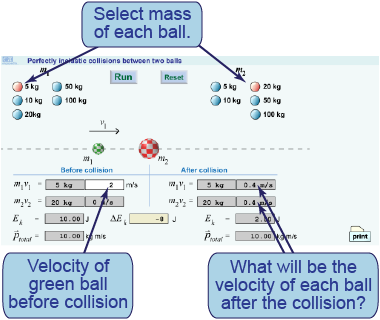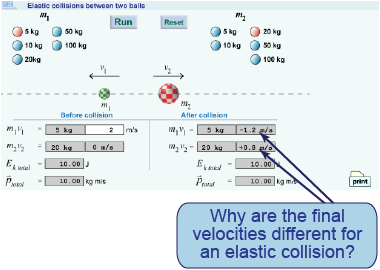|
| Essential questions | | How can we predict the outcome of a collision? | |
|
In an elastic collision, both kinetic energy and momentum are conserved. This means that we can predict the outcome of a collision if we know the energy and momentum of the system before the collision. In an inelastic collision, some or all of the kinetic energy is transformed into other forms of energy (called losses). Momentum, however, is still conserved in an inelastic collision, just as it is in any collision. In this investigation, you will predict the outcome of collisions involving one moving ball and one stationary ball (the target). 
|
Part 1: Perfectly inelastic collisions

- The interactive model simulates a perfectly inelastic collision between two balls.
- [Run] starts the simulation. [Stop] stops it without changing values. [Repeat] resets the final values to zero and runs the simulation again.
- Select an initial velocity for the moving ball.
- Run the simulation for different combinations of masses for the red and green balls. For each combination, tabulate the masses and velocities.
- Examine the table for patterns in the data.
- Describe the velocities before and after the collision when masses are equal.
- Describe the velocities (before and after) when the red target ball has more mass.
- Describe the velocities (before and after) when the green ball has more mass.

|
|
In this simulation the green ball hits the stationary red ball. Both balls stick together after impact, which is a perfectly inelastic collision. Investigate the different combinations of mass for the two balls. Use your data table to record the initial and final velocities for each combination.
|
Part 2: Elastic collisions

- The interactive model simulates the collision of two elastic rubber balls.
- Run the simulation for different combinations of masses for the red and green balls. For each combination, tabulate the masses and velocities.
- Describe the velocities before and after the collision when masses are equal.
- Describe the velocities (before and after) when the red target ball has more mass.
- Describe the velocities (before and after) when the green ball has more mass.
- Describe the measurements that must be made with a collision apparatus, such as this simulation, to distinguish between elastic and inelastic collisions.

|
|
In this simulation the green ball has an elastic collision with the stationary red ball. Both balls may move after the collision. Investigate the different combinations of mass for the two balls. Use your data table to record the initial and final velocities for each combination.
|

